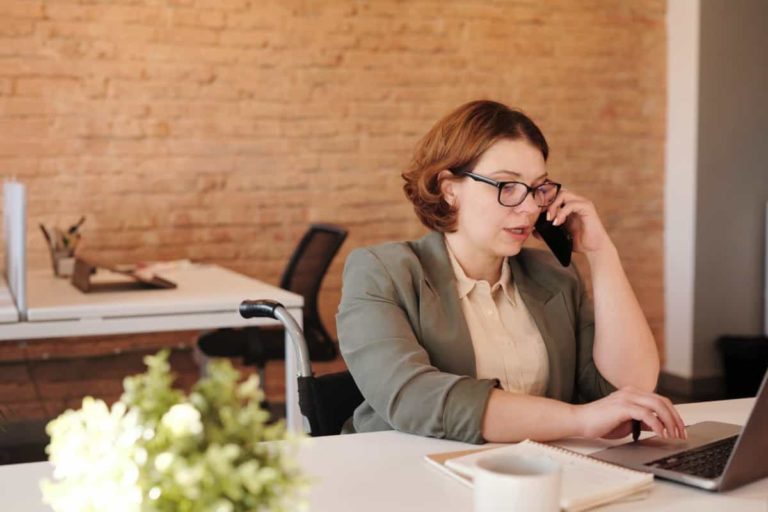Does your job require you to sit at a desk or counter all day? Are you confined to a chair because of the realities of old age or due to disability? Addicted to watching TV perhaps?
You’re not the only one. It’s not just office workers and the elderly who are sitting too much, approximately 80% of modern day jobs are sedentary or consist of mainly light activity.
Since sitting is so detrimental to your health, it’s crucial to learn how to avoid the harmful effects of prolonged sitting.
After all, studies show that inactivity for long periods of time causes the metabolism to slow down, thus blood sugar levels to become unbalanced, blood pressure to rise, and fat to store on your body.
Thus possibly leading to obesity, type 2 diabetes, certain types of cancer, heart failure, and premature death.
Research shows that siting for 8 hours or more daily without exercise is about as lethal as being obese or a tobacco smoker.
But you already know this, right?
So we’ll cut to the chase and tell you how to stay healthy if you’re sitting for long periods of time.
The good news? There’s solutions for those who are ‘glued to their seats’ too. Because sometimes, sitting less just isn’t an option.
A quick rundown of the healthy sitting tips provided here:
- wake up to the reality of sedentary lifestyles
- build good habits
- implement mini workouts
- fidget
- realize that sitting sucks (you in)
- stop being spellbound by your screens
- be aware that being too busy is a myth
- stretch like a cat
- do desk yoga
- sneak in supplemental sports
- indulge in isometric exercises
- use this popular exercise office chair
- hack your work seat with this simple tool
- move on the spot while on your seat
- bow down to the benefits of the kneeling chair
- ‘deskercise’
- boot sitting disease with this gadget
- shed sedentary life with a seated leg exerciser
- stand up to sitting dangers with a standing desk
- hold your ground on an anti fatigue mat
- remember that -seated or not- moving more is NEAT..
How To Reduce The Negative Effects Of Sitting:
General Tips
Advice not directly related to the workplace or retirement home.
Luckily, there’s quite a few things you can do to negate the ill effects of lethal sitting. Many of these solutions work for both those with sedentary jobs as well as people with limited mobility.
1. Awareness is the first step to improvement
Realize that we’re living in unprecedented times. As a species we’re in a weird evolutionary stage.
At work, many of us are virtually chained to our desk or drivers seat. At home we spend most of our time watching TV or behind the computer.
Yet inert sitting for 8 hours or more each day is not what Mother Nature intended. Human bodies are made to move.
Researchers found that immobilization stress in rats caused “severe morphological changes in the heart muscle, lungs and kidneys”.
Cro magnon man didn’t sit on his butt all day gazing, at a screen. They walked, hunted, gathered, made fire, cooked food, created art.
Neanderthals, too, knew better than to sluggishly stare at the walls of their caves all day long. Essentially, we modern humans, have evolved into “Homo Sedentarius”.
‘Modern’ society has placed us humans in an unnatural situation. So make sure to adapt. Or face the consequences.
2. Make a habit out of moving more

Incorporate physical activity in all kinds of situations and as often as possible. During your working hours as well as in your free time.
Walk to a coworker’s desk to deliver a message instead of emailing them. Make a habit out of rearranging your desk.
Take phone calls while standing, pacing or walking. Pro tip: go outside and get a breath of fresh air while you’re at it. Go for a bike ride just for the sake of it.
Use the stairs. Walk up escalators. Stand on the bus or train. Take up a hobby such as dancing, DIY, or gardening. Join or start a walking club.
Engage in calisthenics (fancy word for exercises where you use your own body weight such as push-ups, squats, crunches) whenever possible and/or appropriate.
Carve out a minute here and a few seconds there to stretch, turn, and bend those muscles.
3. Work in mini workouts
Perform mini workout sessions throughout your day. Many micro workouts quickly add up. Set a timer or use a trigger such as walking past that playground to do a few chin-ups. Do a few lunges every time you’re passing the corporate staircase.
Be creative about getting your intermittent mini exercises. If you’re self conscious about doing exercises out in public when you’re not wearing your tracksuit or yoga pants, go the covert exercise route.
For instance, do a squat while pretending to tie your shoelaces. (Want to get used to stepping out of your comfort zone? Google why Tim Ferris why promotes lying down in public spaces.)
4. Fidget like a freak

Seriously, fidget like you mean it. True, fidgeting is often frowned upon as it’s deemed distracting in professional or educational settings. But unjustifiably so as various studies [2] show fidgeting not only boosts focus at home, school, and work but also mitigates the adverse effects of prolonged sitting.
Next time a co-worker lifts an eyebrow, explain to them that researchers found that the mortality risk associated with sedentary behavior in general and sitting in particular significantly decreased in fidgeting test groups.
Oh, it seems it can burn an extra few hundred calories a day too.
So play, wiggle, wobble, jiggle, shimmy and twitch all you want because it’s part of a healthy lifestyle. Put a positive swing to your behavior and use a fidget spinner or another tool that doesn’t disturb your direct environment as much as frantic pen clicking or leg shaking.
5. Resist the idling appeal of the seat

Sitting makes lazy. The less you move, the weaker your muscles get. Which makes you tired faster so you’ll want to sit down. Before you know it you’ll up in a downward spiral.
This negative feedback loop partially explains why your seemingly comfy desk job makes you feel exhausted when you get home at the end of the day.
Office fatigue is also caused by stress, sleep deprivation, overthinking, lack of motivation. We’ll tell you how to fix this, too, in a bit.
Bottom line, whether caused by the sedentary characteristics of your job or physical inability, if possible, avoid periods of inert sitting lasting 30 minutes or more.
When it comes to the time spent on a seat…
These two methods make sitting less unhealthy…
When seated for too long, your veins stretch, your blood stagnates and your muscles weaken. The solution is simple and twofold. You gotta keep mobile while you sit and break up sitting bouts by getting off your butt to get your blood flowing and muscles moving.
So, fundamentally, there’s two approaches to take:
- move from your chair,
- move on your chair
Or in other words:
- Get up from your chair more often
- Increase your physical activity while seated
A. Reducing the adverse effects of sitting:
MOVE FROM YOUR CHAIR
The ‘break sitting time’ method
6. Withstand the spellbinding screen

Whether it’s your game or office computer, your TV, or smartphone, the screen draws you in. Hypnotizes you. Keeps you glued to what’s on there. You lose track of time.
Suddenly you look up and realize not 30 minutes but 3 hours have passed. All the while you’re rendered physically inactive. So habituate getting up at every commercial, before starting a new computer task, after every end boss you kill.
Don’t underestimate the temptation of the screen. It’s extra tricky because watching TV makes you slip into a sort of hypnotized trance state. Your vital signs plunge. Lower alpha brain waves create a kind of zombie effect.
The slow, synchronous brain pattern causes the typical passive mindset, inhibited thinking and discernment, inactivity, and overall body inertness accompanied by screen gazing.
So use an external reminder to break the spell. Set an alarm to get up, stretch or move a bit every 30 minutes. Use an old fashioned alarm clock instead of your smartphone because notifications on another screen might cause even more distractions.
As a rule of thumb, quit sitting hours on end in front of a TV or computer. Stand up and move during TV commercials or in between computer tasks. Walk in place while watching TV.
Muster the willpower to start watching TV a bit later than usually. Television is electronic heroin, when you turn the tube on in the evening it’s almost impossible to turn if off again.
7. Remember this: you’re not that busy..
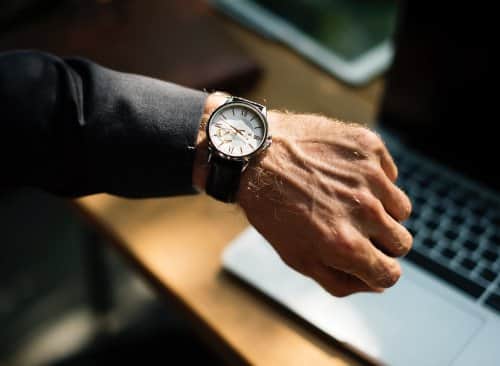
Think you’re too busy to go outside or to the cafeteria for lunch and have to grab a quick sandwich at your desk instead? Got no time for a trip to the water cooler?
You’re wrong.
“Being busy is a form of laziness”. By being selective, by focusing on the stuff that really matters you’ll be more productive.
Take time to contemplate. To rest. To do nothing. Like Taoism advocates, no yin without the yang. And vice versa. Bring about a balance between action and non-action. Between sitting and not sitting. You will get a much clearer picture of which things you are doing are useful and which not.
You know, the Pareto principle a.k.a. the 80-20 rule. And you know what definitely belongs to that 20% you should focus on? Your health! So stop making excuses about being to busy for getting up from that chair.
Your employer won’t be convinced?
Tell them to look up neuroscientist Mark Waldman. His research shows that taking two to three breaks during each hour to stretch, relax, meditate, or do something fun (if only for 10 second) significantly increases your concentration and productivity.
B. Make sitting less unhealthy without sitting less:
MOVE ON YOUR CHAIR
The ‘move as much as possible while you’re sitting’ method
Even though you’re seated you can probably still move more than you’re used to. Bend and unbend your legs. Pull your knees up to the underside of the desk surface or steering wheel. Do some ankle circles, arm circles, neck stretches, or bend and unbend your legs.
Similarly, we’re getting to the next one that might seem like a weird thing to do deliberately. Especially in front of your coworkers but it actually makes a whole lot of sense.
Just hear me out..
8. Deploy the power of pandiculation
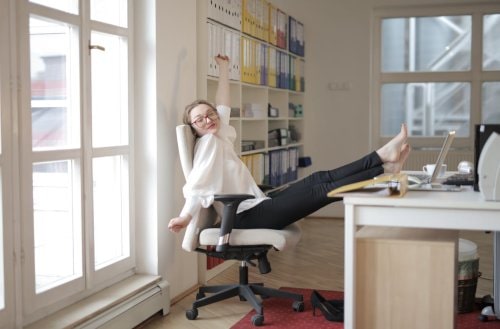
Pandiculate! Or, in other words, stretch like a cat. Pandiculation refers to the way you’re stretching while you’re yawning. Babies do it all the time. Animals don’t stretch, they pandiculate. Cats and dogs arch their back and stretch their forelegs after a nap.
Neuroscientists [3] have discovered that pandiculation, and not stretching, improves posture, increases mobility and reduces pain.
This pandicular response, that often occurs automatically after we’ve been physically inactive for a while, has a purpose. Research shows it’s as crucial to our wellbeing as a balanced diet and regular exercise.
Pandiculation, a.k.a releasing muscle tension, is how your nervous system wakes up your sensorimotor system and prepares you for movement by sending biofeedback to your brain about how tight your muscles are. In essence it’s a natural way to reset your body processes before getting active again.
It helps loosen your muscles and fascia thus preventing stiffness and pain in joints and tension in muscles as well as poor posture.
Sitting all day long can cause your muscles to stay contracted in your ‘chair sitting posture’. Repetition teaches the muscles to hold that same position every day. Pandiculation can fix this.
For reasons of social conditioning and being too busy and whatnot, we tend to suppress this natural bodily response. Which is why simulating it before getting up from your seat can be tremendously helpful.
It’s free, it’s natural, it’s healthy, and yes, a bit weird perhaps but who cares, it’s for your health. So get into the habit of indulging in intermittent cat-like stretches.
Scoot your Aeron Miller a few feet away from your desk and yawn while doing a ‘full-body, arms overhead, legs extended, toes and fingers spread wide’ stretch.
More specifically, contract tight muscles, then slowly lengthen them, then completely relax. It will make you feel less tense, refreshed, connected even and you don’t have to necessarily yawn while doing it. Give it a try.
Similarly…
9. Practice chair yoga

Did you know there’s a wide range of yoga poses you can do at your desk? Or on your couch or power lift recliner, for that matter.
Not only does desk yoga (or couch potato yoga) reduce stress and discomfort, it boosts your energy levels and helps negate the adverse effects of sitting all day long.
Do the ‘seated tadasana’ to thwart text neck. Exert the ‘shoulder opener’ to avoid mouse shoulder. Execute the ‘seated side stretch’ to neutralize slump back.
Flex your legs to evade e-thrombosis (research shows desk-bound workers are twice as likely to suffer from DVT). Or practice the ‘wrist and finger stretch’ to counteract your frantic typing.
10. Covertly conduct office exercises

Say what? Desk yoga is not an option because Bill Lumbergh is your supervisor?(fans of the movie Office Space will know what I’m talking about).
Pulling out a resistance band or doing the desk chaturanga will be frowned upon in your workplace?
No problem.
Start doing mini exercises secretly. Stop staring at the machine spewing out copies and do some leg lifts and swings a.k.a ‘copy machine calisthenics’.
Execute a few unobserved ‘under desk body weight leg extensions’. Strap on some ankle weights to make your under-desk leg lifts more intense.
Turn your body to block from your boss’s view a set of ‘water bottle bicep curls’. Perform a few stealthy shoulder retractions and make it seem as if you’re adjusting your computer screen position.
While we’re on the subject of discrete exercises while at work…
11. Indulge in isometric exercises
Also known as static strength training, isometric exercises are contractions of a certain muscle (group) during which the affected joint doesn’t visibly move. Therefore, the exercises can be performed inconspicuously.
Not only do these offer carpal tunnel, arthritis, and stress relief, isometric exercises also offer simple ways to stay healthy when you sit a lot.
Computer workers can benefit from the relief that hand squeezes bring to the fingers. Simply make a fist, squeeze, hold, and release, and stretch your fingers. Repeat this a few times. Using a stress ball is optional.
Or get the Activ5 isometric exercise gadget that allows you to discretely do various of its many exercises at your desk or drivers seat while waiting. This portable, smart fitness tool/ tracker is like a tiny gym in your pocket.
Another one that can be performed while sitting is outer thigh presses. Put your palms on the outside of your thighs just above your knees. Press your thighs against your palms for 30 seconds.
These are just a few examples. There are static exercises for practically all muscle groups such as shoulders, neck, biceps, you name it.
Besides doing mild on-the-spot exercises there are various seat adaptations as well as office chair alternatives that stimulate movement while you’re sitting.
SIT ON AN ACTIVE SITTING CHAIR
The scientific discipline of ergonomics recognizes that static sitting constitutes a health risk and that dynamic sitting, or active sitting is beneficial to both body and mind.
An archaic form of active sitting, we’re all familiar with, is the rocking chair. The past years, a wide range of dynamic sitting chairs and stools of various designs and has been developed to meet the needs of users in various situations. There’s even an office rocking chair.
12. Perform office chair abdominals with a balance ball
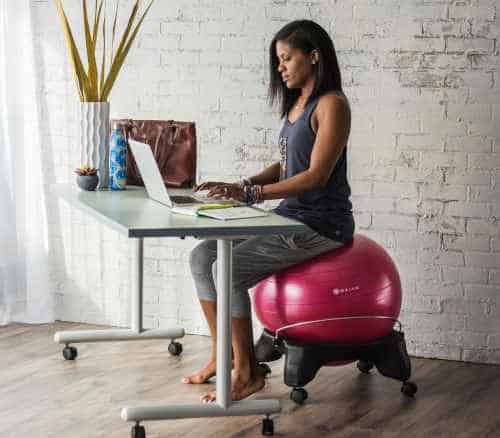
Switch your desk chair for a yoga ball. If only for an hour per day. Sitting on a exercise ball or stability ball, as they are called as well, is a workout in itself as its inherent instability engages your core muscles.
Thus increasing your abdominal strength and improving your posture. Users report less discomfort and pain from traditional sitting and more energy.
Sitting on this type of fitness equipment might encourage intermittent exercise. Roll the ball back from your desk and do a wall squat, Deadbug, Russian Twist, a few knee raises or ab crunches.
Obviously this option might not be for everyone. It takes time to get used to and due to its instability it’s less safe than sitting on a traditional chair.
On the other hand, there’s balance ball chairs with legs or a base such as the Gaiam Classic and, a spin-off, the also very popular Safco Zenergy.
13. Hack your work chair with a stability disc
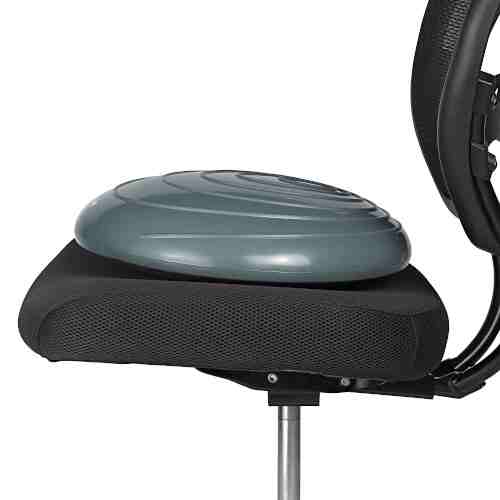
Sitting on a chair slackens your abs and, eventually, makes your core muscles mush. You start slouching and after 8 hours or more there’s that aching back and creaky neck again.
Transform your conventional desk chair into an active sitting seat by adding a squishy wobble cushion. Its instability as well as the fact that your not sitting on a flat surface makes your core work and your posture rebound.
Adjust the disc’s firmness to meet your personal needs. Users report reduced stiffness, back pain, improved posture, and increased energy levels.
14. Keep moving on the spot with a learning chair
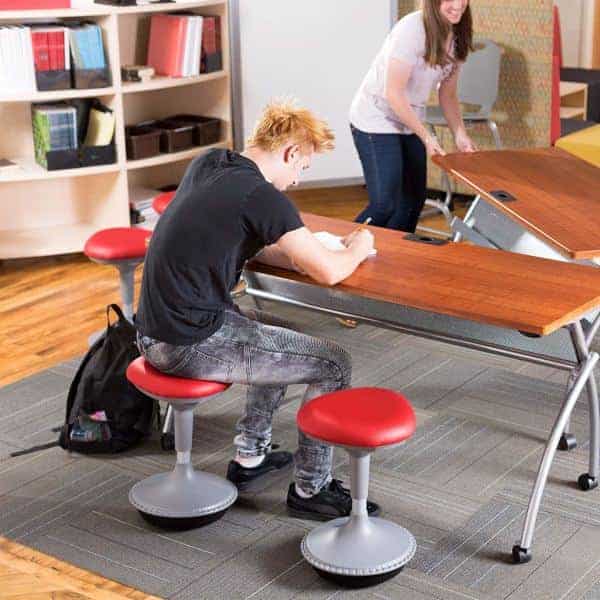
Even ergonomic office chairs with lumbar support often don’t actually encourage proper back posture. Often, with these chairs the natural curve in the lower back (lumbar spine) isn’t maintained.
Which is why some ergonomic experts recommend backless seats to build abdominal strength and promote proper posture.
Learniture stools are designed with energetic users in mind. The non-slip curved base allows for multi-directional rocking motion which mitigates sitting side effects and enhances focus.
If you’ve got excess energy or not, a Learniture active learning stool has shown to enhance posture, boost productivity, confidence, and yes, energy. It’s one of the most popular, well-reviewed seats that helps reduce the adverse effects of sitting.
15. Bow down to the power of the kneeling chair
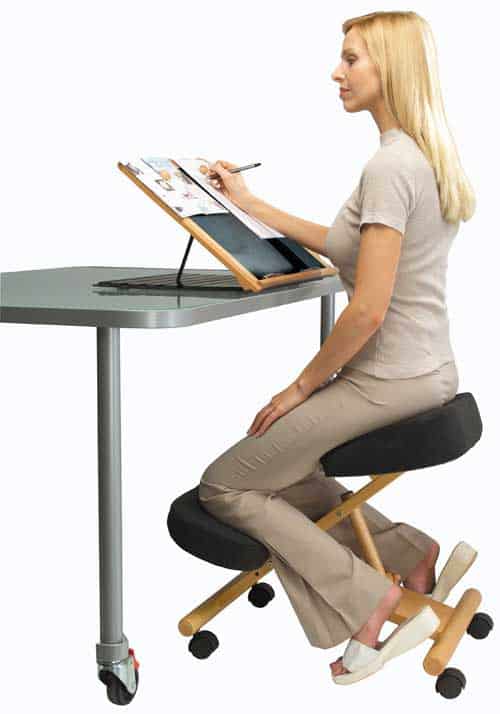
The kneeling chair is another seat that promotes active sitting. Sitting on the kneeling chair involves more muscle activity and avoids the static positions that wreck your back and neck.
Your pelvis is tilted so your spine is in a more healthy position (natural S curve). Your body weight is distributed between the buttocks and shins which especially alleviates lower back and tailbone (coccyx) pain.
More movement while sitting and maintaining a natural lumbar curve ensure enhanced metabolism, better circulation so more nutrients are carried to your brain.
Thus you’ll feel fitter and be more motivated.Like the other active seating examples the kneeling chair, too, helps reduce office fatigue.
A downside, since it’s less easy to get up from a kneeling chair than a normal chair there’s a slight barrier to getting many quick few minute stretch breaks.
16. ‘Deskercise’ with an under desk leg exerciser
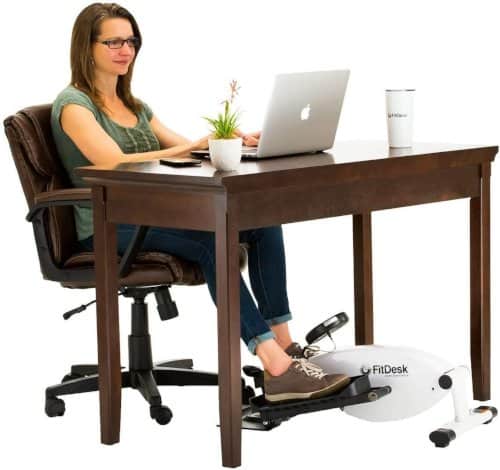
Under desk exercise equipment may seem to the uninitiated as a quirk for fitness fanatics but they would be surprised. Not only can you squeeze your cardio session into working hours…
In fact, under desk ellipticals and portable pedal machines offer a healthy, convenient way to counteract sitting at a desk all day. Researchers found that “just 23 minutes of pedaling could boost health if done regularly”. [7]
We all have these days when leaving your desk every 30 minutes just isn’t an option. You’re simply too busy or you don’t want to interrupt your flow. An under desk exerciser offers the perfect way to keep the blood pumping without constantly getting up from your seat.
Worried your sedentary lifestyle, like so many before you, makes you fat? Get an under desk pedal machine and break the cycle. (sorry, I couldn’t resist)
17. Boot sitting disease out with Bouncy Bands
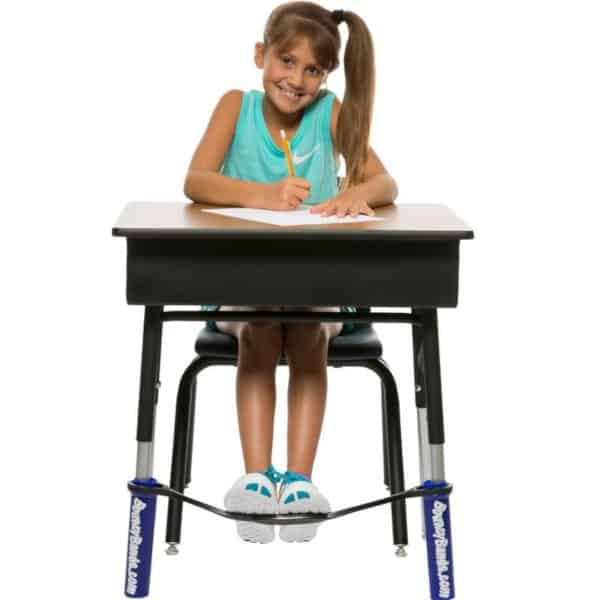
Think these are just for people with ADHD and fidgety kids? Think again. Bouncy Bands can be a game-changer in improving sedentary lifestyles. Stretch your legs and fidget your feet without distracting others.
Channel that superfluous energy into a productive, healthy sitting session.
Long periods of sitting puts serious strain on your body. Bouncy Bands can help increase blood flow to your legs which is a great help to those with diabetes or DVT.
The bands help reduce the risk of obesity, diabetes, depression, and plaque buildup in the arteries (atherosclerosis). Bouncy Bands work great to give restless legs and anxious leg bouncers an outlet too.
18. Shed sedentary life with a passive leg exerciser
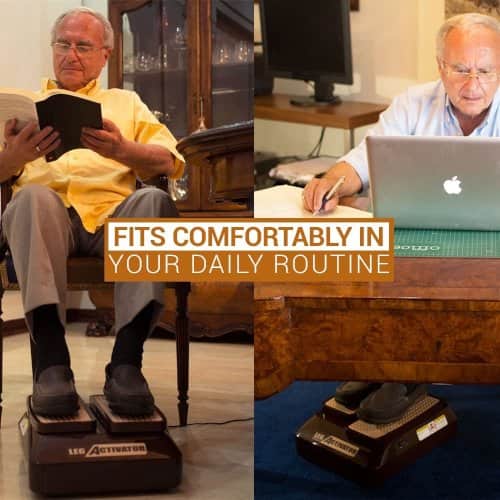
We need to stay physically active to stay healthy. But if you get older, sick, disabled, or are recovering from injury, getting your much needed exercise is often inhibited. Thus posing a barrier to maintaining fitness and health.
Moving around becomes even more difficult. Balance and gait deteriorate, which in turn, often involves a spiraling risk where immobility further increases and with it the risk for additional illness such as hypertension, diabetes, and stroke.
A passive exercise machine can be a literal life safer when it comes to escaping the downward spiral of exercise capacity. It allows people for whom traditional exercise is not possible or painful a means to keep moving from the comfort (or confines) of their chair.
A passive leg exerciser is a motor-driven stationary device that moves the user’s legs for 30 minutes. This way it strengthens muscles, prevents freezing cold feet and legs, varicose veins, ulcers, fights cellulitis, and helps get rid of sitting damage in general.
Put an end to functional decline by staying mobile with a little bit of help from the LegActivator seated leg exerciser.
19. Stand up to sitting dangers with a standing desk
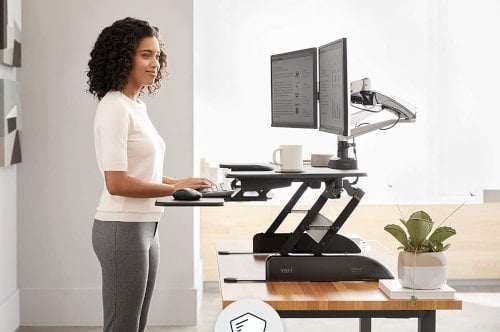
Take a stand and switch to a standing desk. If only for short periods of time during the day with a sit-stand desk such as the Vivo riser workstation which allows you to almost effortlessly alternate between sitting and standing.
Working at your desk while standing upright increases muscle, bone, cartilage, ligament, and tendon strength.
Since your back is straight, your posture is correct which enhances blood flow to the heart and oxygen transfer to the lungs. By standing you’re making micro movements which prevents stiff and achy joints.
20. Hold your stance on an anti fatigue mat
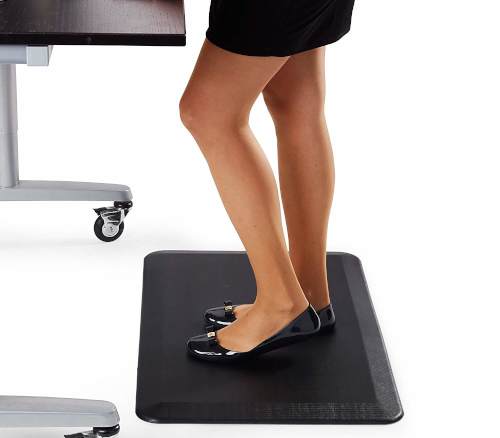
Anti-fatigue mats are softer than workspace floors such as tile, concrete or wood making them a game changer if you tend to stand a lot. Whether it’s behind a counter, in a kitchen, or in an office setting.
Just like supportive shoes can make all the difference for standing all day or walking a lot, a cushioned standing desk mat can make standing much more pleasurable and feasible as it supports your feet, legs, and back. The contoured surface is designed to encourage gentle movement.
Wanna spice it up? Take an extra wide anti-fatigue mat that allows you to stand with your feet hip widt apart and do a little stretching or try some other standing position variations.
Try this marching technique to walk in place. Lift your heals towards your buttocks and place them back on the mat in a quick pace. Perhaps safer when performed on a flat mat.
Stand your ground against the negative effects of sitting with this popular budget choice, the Comfilife anti fatigue floor mat.
One final piece of advice…
21. Keep in mind that moving more is NEAT
Let’s tie all these ‘minimize sitting side effects’ tips up in a neat little bow.
This harks back to tip #2: Make an habit out of moving more. Basically it draws down to this. Sitting all day is bad for your health, even if you exercise afterwards.
So make sure to be less inactive throughout your day. Move on your seat and regularly stand up and get away from it.
Medical experts recommend to expend more energy on “non-volitional muscle activity” such as posture maintenance, muscle tone, and fidgeting.
In other words, increase your “non-exercise activity thermogenesis” or NEAT.
NEAT simply means moving when you’re not exercising. The more you move, the more you increase your ‘physical activity-related energy expenditure’ (PEE), the less sedentary you are.
This can be while performing virtually any task. We’ve mentioned a few already.
Other examples of movement outside of structured exercise include; walking, sweeping the floor, raking leaves, cleaning, cooking, shopping, hauling groceries, doing errands and housework, walking the dog, and so on.
Elevating your NEAT increases metabolic rate and studies indicate that people who continuously move during their day are more likely to reach or maintain weight loss goals than people who sit still all day and vigorously participate in one exercise session.
So make sure to don’t just EAT (exercise activity-related thermogenesis) but change your way of life. Drastically change your daily routine by upping your occupational and leisure NEAT and you might be able to skip your daily trip to the gym.
Optionally, a fitness tracker, a.k.a activity tracker will buzz every so many minutes to remind you to get movin’. It can help you monitor your daily consumed calories, distance walked, heart rate, sleep quality, and more.
You’ll be healthier, feel more energetic and confident, and look better.
Now that’s pretty neat, don’t you think?
Did these tips on how to step away from a sedentary lifestyle help you out?
As you now know, it is possible to make sitting less unhealhty without actually sitting less. Various tips, tricks, hacks and gadgets exist to make your seated life healthier and more pleasant. We would love to know what you think of these solutions.. Do you have anything to add? Came up with your own tricks? Share your thoughts below..
References
1. Prolonged work- and computer-related seated immobility and risk of venous thromboembolism. Source: PubMed.
2. Everyday attention and lecture retention: the effects of time, fidgeting, and mind wandering . Source: Frontiers in Psychology.
3. The Effects of Breaking up Prolonged Sitting Time: A Review of Experimental Studies
4. Why Pandiculation NOT Stretching Reduces Pain, Improves Posture & Increases Mobility. Source: TotalSomatics.com
5. Sitting on Stability Balls: Biomechanics Evaluation in a Workplace Setting. Source: Taylor & Francis Online.
6. Patterns of Sedentary Behavior and Mortality in U.S. Middle-Aged and Older Adults Source: Annals of Internal Medicine.
7. Portable pedal machines may help counter harmful effects of sedentary jobs. Source: ScienceDaily.
Last Updated on September 7, 2022 by Tyler

